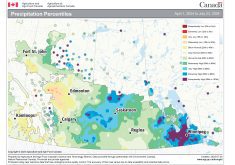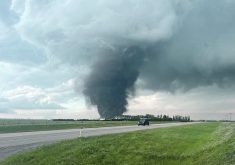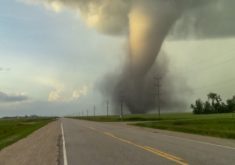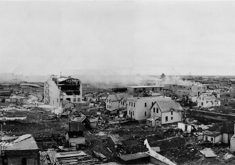No significant injuries were reported, but some livestock were killed and there was extensive damage to rural properties and crops
An Alberta ranching family whose farm was devastated by a tornado estimated to be among the most powerful ever detected in Canada are relying on their Christian faith as they deal with the damage.
“When I drove in here, I turned my lights on and I just cried because there’s nothing left from my grandpa, there’s nothing left from my dad, there’s nothing left for my brothers,” said Darlene Bowen about the Kellsey family farm.
“And having said that, I know that it’s not an accident that God allowed this tornado to be on our property, and we didn’t actually own the land to begin with. God owned the land. We were just taking care of it…. I also know if He chooses to put an EF4 tornado in our path and all that power, He can also take care of my family with no question whatsoever.”
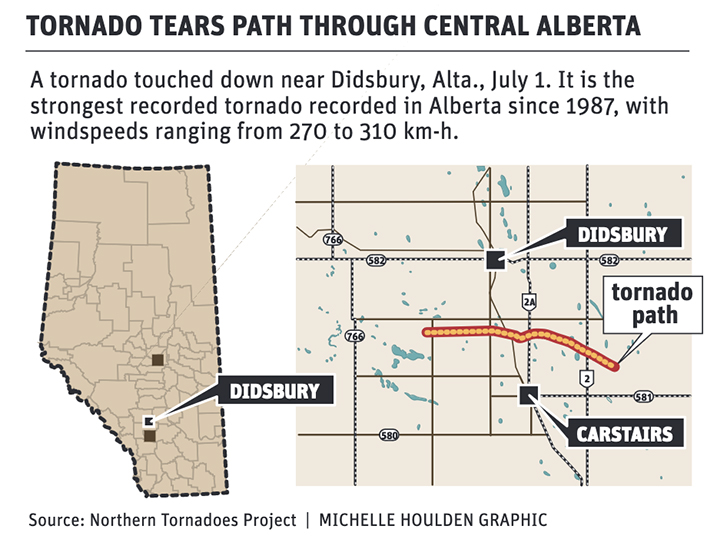
No one was killed after a tornado with a path estimated to be up to 620 metres wide — about three times the size of a typical tornado in Alberta — travelled 15.3 kilometres starting about 1:45 p.m. July 1, said meteorologist Terri Lang of Environment and Climate Change Canada. “It was about two to three kilometres south of Didsbury, so a very near miss.”
It happened on Canada Day between Didsbury and Carstairs, which have a combined population of about 10,000 people. They are only about 11 kilometres apart along a northwest-southeast axis.
If the tornado had shifted in either direction, “I think it would be a much sadder story than we’re talking about today,” said Connell Miller, an engineering researcher for the Northern Tornadoes Project at the University of Western Ontario.
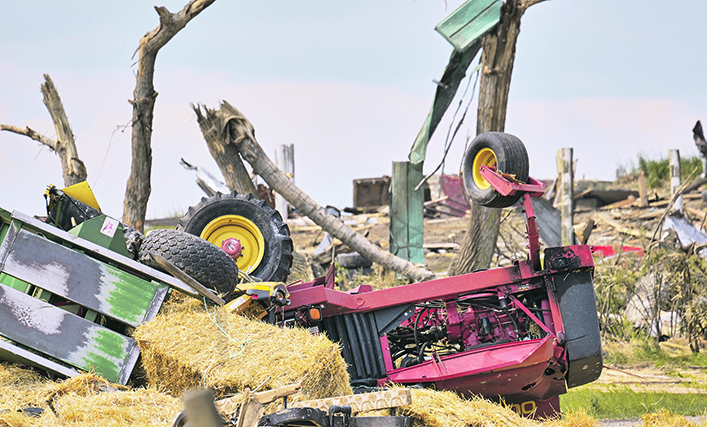
Researchers who examined the damage estimated the tornado was an EF4 on the Enhanced Fujita scale, which goes from zero to a maximum of five, said Miller. It was the most powerful tornado to hit Alberta since one that struck Edmonton on July 31, 1987. It killed 27 people, injured hundreds of others and destroyed millions of dollars in property, he said.
Although injuries during the latest event were limited to a minor cut received by a first responder, the tornado picked up intensity near Highway 2A where most of the damage occurred, he said. It was so strong that trees were stripped of bark, snapped and thrown for kilometres, he added.
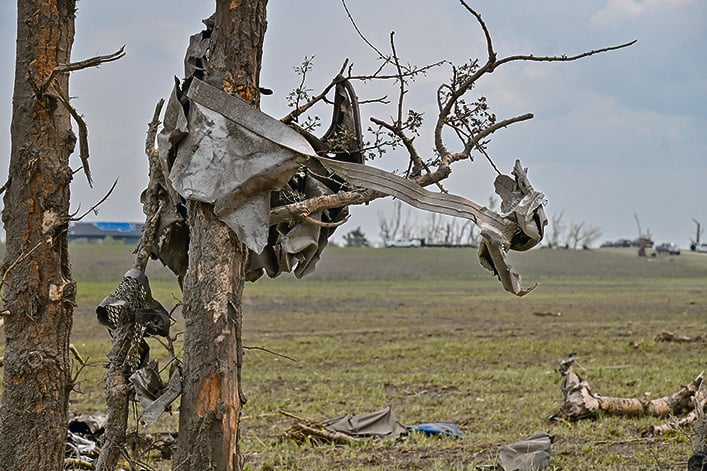
Three rural homes were destroyed by winds that reached up to 275 km-h, with four rendered uninhabitable and a further five damaged, said Miller. Only 21 EF4 and EH5 tornadoes have been detected in Canadian history, he said.
“If it does any sort of damage to any sort of residential structure, there is expected almost to be fatalities of some sort, just like there was in the Edmonton tornado. But thankfully… people that were in vulnerable positions got the warning and found safer shelter, and it’s again a miracle that no one was killed.”
First responders included the Carstairs, Didsbury and Olds fire departments, along with the RCMP and Alberta Health Services, said Jordan Schaffer, chief of the Carstairs Fire Department. He likened the damage to that of a war zone, pointing out how a crumpled metal shipping container, also known as a sea can, travelled as far as 400 metres.
“There were flying sea cans, just shreds of plywood and drywall everywhere, and cars just mangled. Farm machinery that was almost unrecognizable.”
Livestock deaths included about 25 cows that had to be euthanized by the RCMP, along with a horse put down by a veterinarian, he said. About 70 chickens also died as well as other animals, he added.

The tornado destroyed the Kellsey family farm, said Bowen, who grew up on the property as the sister of brothers Lavern and Ray Kellsey. It lofted a combine weighing nearly 10,000 kilograms about 50 metres over a hill, crumpling the machine as it rolled a further 50 to 100 metres, said Miller.
Bowen said Ray’s wife, Diane, was rescued unharmed after being trapped in the basement when the farmhouse above her was demolished. She had been sitting in a chair, where she prayed God would hold her.
“And when you go down those stairs, and now that we’ve cleaned things out, her chair is sitting there and there’s rubble all the way around her chair, and there’s not one thing where she was sitting.”
One of her rescuers was her son, Travis, who lived in a nearby house. After receiving a tornado warning and looking out the window to see the funnel cloud, Diane had just enough time to warn Travis, his wife and their one-year-old baby to get into their own basement, said Bowen.
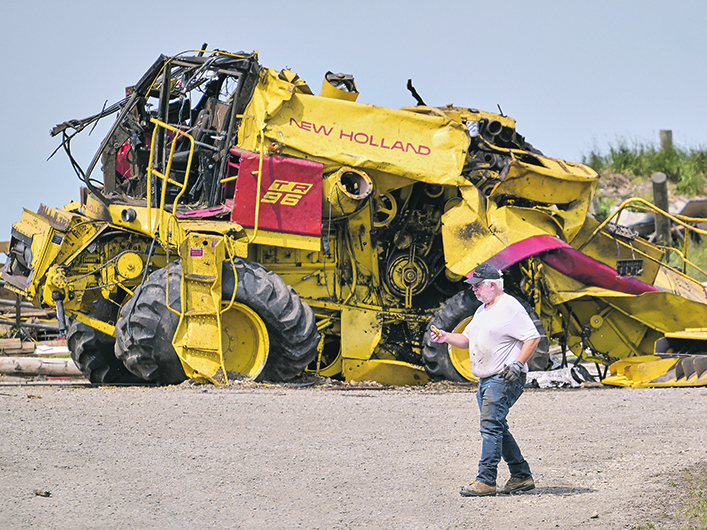
“They barely got to the top of the stairs when the straw started to fly. By the time they were at the bottom, the tornado was full on.”
Although the front windows and back wall were blown out, most of the contents of Travis’ home stayed inside, said Bowen.
“However, the house is dicey as to whether you should go in or not.”
Lavern’s daughter lived in a nearby mobile home. She was at work when her home was destroyed by the tornado, said Bowen.
“The trailer, there’s almost nothing left,” she said.
“They were able to get their clothes out, but that was it. And the main house, we were able to salvage some things like rings and some clothing, but most of the main house has blown away.”
The damage included nearly all the farm’s equipment and outbuildings, said Bowen.
“We had a hay shed. We had a big machinery shed out back, the silage pit is gone, the barn that was there before my grandpa bought the land — so quite an old barn, but very well constructed — it’s totally trashed.”
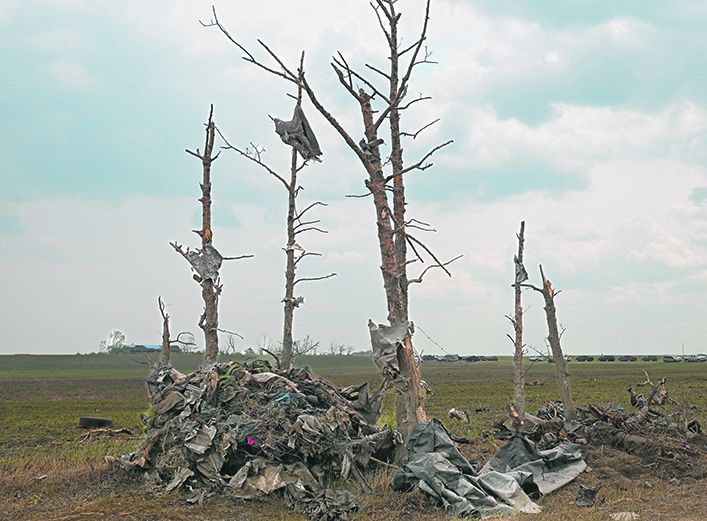
The farm contained a cow-calf operation that included yearling bulls in corrals. Although exact losses were still undetermined as of July 5, they may have lost as many as two dozen cattle, said Bowen.
Her father, Garry Kellsey, was a noted cattle producer who passed away about 18 months ago at 81 after suffering a heart attack.
“And we’re grateful that he didn’t have to watch this.”
Bowen estimated thousands of people drove along Highway 2A to see the damage the following day. She said up to 60 volunteers, including neighbours, helped the family recover some of their belongings. They included photographs that travelled more than three kilometres, she said.
The Kellseys must now start the long process of deciding the fate of their farm, which they have owned since 1944, she said.
“First of all, we need to know what the insurance adjuster is going to do, and then both my brothers are at retirement age, and so there are a few decisions that will have to be made.”






